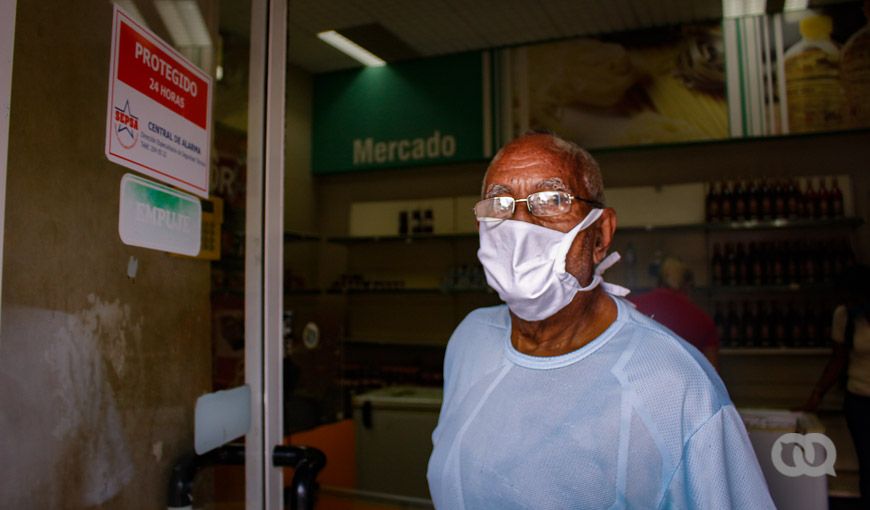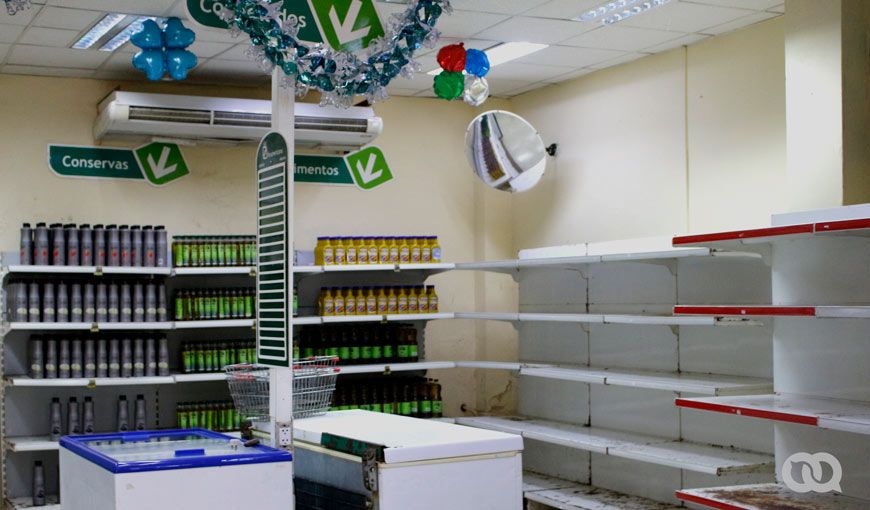
Mercadito de la tienda La Cordial en Santiago de las Vegas. Foto: Jessica Dominguez
Shops in havana: long live regionalism and inequalities!
30 / septiembre / 2020
Queues at shops, points of sale or banks are the only agglomerations allowed during the social restrictions imposed due to COVID-19. They have been impossible to eradicate or reduce, at most, they are controlled when law enforcement agents intervene. Shopping, especially for food, has been the main concern of most Cubans in these times.
When the government of Havana announced that new measures would be put into effect from 1 September, the limitation of buying only in shops (in CUC) within the municipality of residence, upon presentation of proof of residence, added a new obstacle after the difficulties of online trade, the opening of shops in freely convertible currency (MLC), usually dollars, and the “fight against coleros (queue position sellers) and product resellers”.
In the name of controlling the pandemic and limiting the mobility of citizens – elements which have not been achieved – a discriminatory measure was announced which did not take into account the real possibilities of access to citizens’ products and which put the peripheral areas of the city at a social disadvantage.
The network of commercial establishments and the distribution of products are not equitable in the different parts of Havana. Therefore, there are blessed municipalities where their inhabitants have various shops nearby and others where the few options available are miles away. Not to mention the differences in stock levels between stores.
The two large national companies in charge of retail trade in Cuba, belonging to the Business Administration Group (GAE) of the Armed Forces, are the Cimex Corporation and the Tiendas Caribe chain – which up to March 7, 2018 was the former TRD -, with more than 4800 points of sale in the country.
In Havana, according to the data available in the institutional applications Donde Hay and Caribe, we were able to compile a list of 821 shops, of which we verified that 70 are currently closed for various reasons. Some markets and points of sale of the Caracol shop chain are also open (Comodoro, Palacio de la Artesanía, Playas del Este, Hotel Sevilla, Hotel Habana Libre, Hotel Cohíba, Ánima y Galeano, Sanya and 23 and 12), which provide services to tourism, but the analysis was not included because the data was not available.
Of the total number of establishments signposted, not all have the same proportions. According to Cimex’s classifications, they offer services in Servicentros, Oro Negro, Tiendas Panamericanas, Rápidos, PhotoService, Points of Sale and Kiosks. In the case of Caribe Stores, they have Shopping Centres, Commercial Units, the former TRD, Points of Sale and Kiosks.
It should also be noted that many of the establishments located on the map are grouped around the same address. That means that the 751 points of sale are not in 751 places in the city, there can be up to ten shops, according to the classification of the companies, located in the same street or around a reduced perimeter. For example, when they are inside shopping centres and in the reference centres in the locations.
The largest, most varied and best-stocked shops are also located in the city’s central municipalities. Most kiosks are located on the periphery.
In previous years, the policy of these companies was to reduce the number of sales outlets and concentrate the products in larger shops. This would reduce unnecessary expenses in units with low sales volumes (determined in many cases by the scarcity of offers). However, from the beginning of the pandemic the decision was to close the large, important shops such as 5ta and 42, Carlos Tercero and Puentes Grandes.
In addition, trade was limited only to food, toiletries and hygiene products, and alcoholic beverages to take away. The rest of the departments have been closed for more than six months, the only reason for which is to reduce the number of staff working.
The possibilities of shopping in Havana today are reduced to the number of limited orders that can be accessed from online platforms, the shops in MLC and the rest of the units that remain open.
Recently, the Cimex chain of shops announced that it would gradually relocate all its online services in a shop called Habana on Avenida del Puerto with a quantity of 2,000 orders per day and would gradually close the services provided by the 4 shops that today operate from different points of the city.
This idea to organise the supplies is reasonable, and it is true that centralization seems to be the option to reduce complaints about the difficult access to the platform and the insufficient offer available. However, it again harms the city’s periphery because of the change in transport prices: as the shop is further away, the distances increase and the delivery costs rise.
The shops in MLC, which are not accessible to the majority of the population because they do not have this currency, whose price in the informal market has risen considerably and today ranges between 1.6 and 1.9 CUC for 1 USD, have no restrictions associated with the residence of the customers. This shows the discretionary nature of government policy.
In October 2019, the MLCs started with 12 shops selling household appliances and car parts and accessories in Havana, but the companies announced that their plan was to reach 77 shops throughout the country. As of 20 July, 14 new shops were opened, now in markets, hardware shops and toiletries shops. During these months, construction work and the conversion of shops of other categories to MLC have continued, and so far we have counted 32 in operation in the city.
The government announced that these shops would be for the sale of high-end products, but their supplies are practically the same as in the rest of the shops (when they have any stock). So, in reality, the distribution has been relocated and the shops in CUC have been left behind. They have even started to run out of supplies and after long queues lasting hours, people cannot find all the products they need or were looking for.
Once again, the shops that offer in MLC are mostly located in the centre of the city. Municipalities such as Habana de Este, Boyeros (the largest in the city), Guanabacoa, San Miguel del Padrón, Arroyo Naranjo, Cotorro or Regla are the black sheep of the city.
In a general sense, it is evident that the distribution of the shops is not determined by the area size or the number of inhabitants. Although the municipalities with the highest density coincide with those in the city centre (Centro Habana, La Habana Vieja, Plaza de la Revolución, Cerro and Diez de Octubre) the largest number of establishments (in CUC and MLC) are located in Centro Habana and Playa.
The municipalities of Arroyo Naranjo, San Miguel del Padrón, Regla and Guanabacoa are the most disadvantaged, which also have large distances between the different locations.
In the case of Old Havana, there are more shops, but they remain closed. Some of the shops belonging to the former Habaguanex chain of the Oficina del Historiador (which were divided between CIMEX and Caribe after its closure) were closed before the start of the pandemic in the country.
During the month of September there have been specific actions to bring the products closer to some communities, those that have active foci of COVID-19 and those further away, but in a random not systematic manner, and therefore it is not possible to assess how much all the people in these conditions have benefited.
The city’s inhabitants, in terms of shopping, are not moving around from one place to another for pleasure, especially in the current scenario without public transport. They do so because of the need to satisfy a demand that is not covered in their place of residence, because of deficiencies in the distribution of supplies and in the organisation of the commercial system.
This is not just an operational problem, it is a central issue in people’s lives in which the periphery and less urban areas are at a disadvantage. Limiting the possibility of seeking alternatives for basic survival, when inequalities have been publicly acknowledged, is a way of promoting regionalism and disparities in social development that are increasingly noticeable in the city.
The differences between the areas of Havana were not caused by COVID-19, they have a historical heritage that goes beyond the commercial network, but that is another important element to consider when governing a 500-year-old city whose inhabitants live in 15 municipalities and 728.3 km2.
This article was translated into English from the original in Spanish.


If you believe that our journalism is important for Cuba and its people, we want you to know that this is a critical moment.
Behind each publication there is a team that strives to ensure that our products meet high quality standards and adhere to professional and ethical values.
However, to keep a close watch over government, demand transparency, investigate, analyze the problems of our society and make visible the hidden issues on the public agenda is an effort that requires resources.
You can contribute to our mission and that is why today we ask for your help. Select the way you prefer to send us a donation.









comments
We moderate comments on this site. If you want to know more details, read our Privacy Policy
Your email address will not be published. Mandatory fields are marked with *